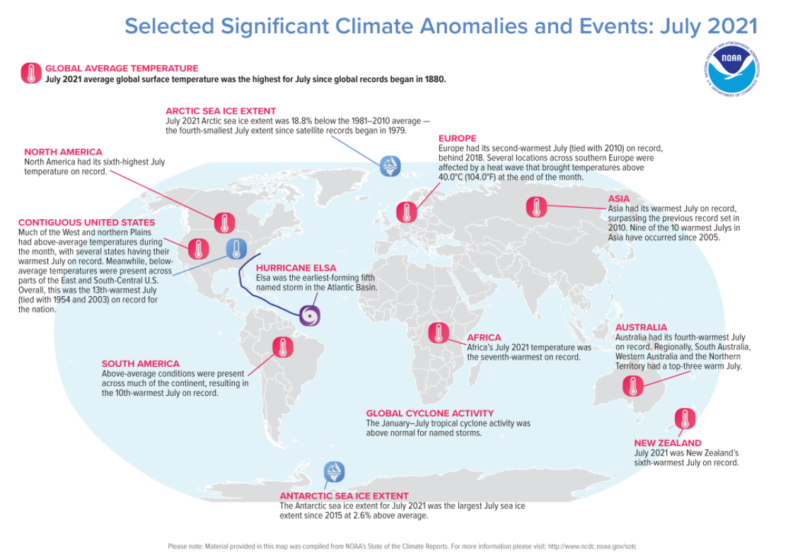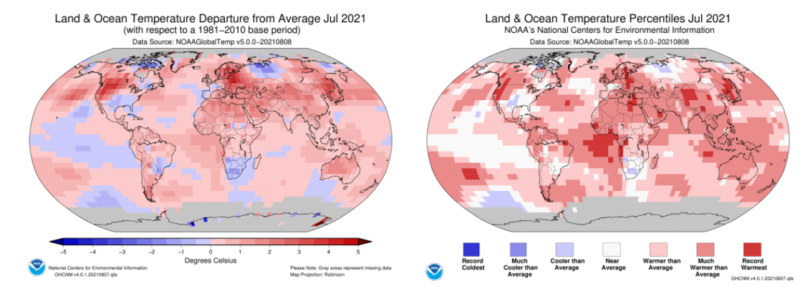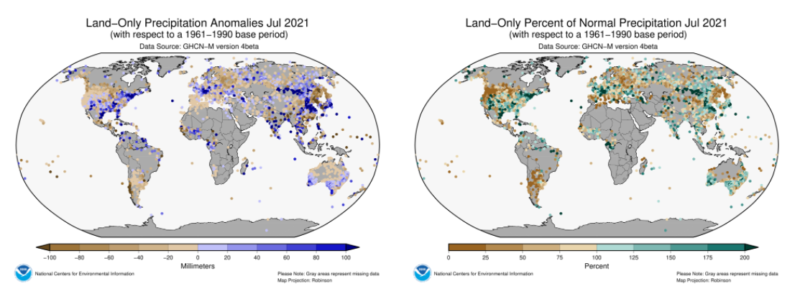Temperature
The month of July was characterized by warmer-than-average temperatures across much of the globe. Much warmer-than-average temperatures were observed across parts of North America, northern and eastern Europe, northern Africa, the Middle East, southern Asia, northern and southern parts of Argentina, as well as the Atlantic, Pacific, and Indian oceans. Record-warm July temperatures were observed across parts of western North America, the Atlantic Ocean, Europe, northern Africa, southern Asia, and small areas across the southern Pacific and Indian oceans. The record-warm July temperatures encompassed 5.06% of the world’s surface — the seventh-highest July percentage for record-warm July temperatures since records began in 1951. Meanwhile, cooler-than-average conditions were present across parts of the south-central and southeastern contiguous U.S., northeastern Canada, southern Africa, northern Russia, and the southeastern Pacific Ocean. However, no land or ocean areas had a record-cold July temperature.
Precipitation
Significantly below-average precipitation occurred across northwestern contiguous U.S. to the Canadian Prairies, much of Argentina, northeastern and southern Europe, and parts of Australia and eastern and southern Asia. Significantly above-normal precipitation occurred in southern and northeastern parts of the United States, northern parts of South America, and parts of Europe, eastern Asia, and southern Australia.
Several locations across southern Europe had drier-than-average conditions during the month. The dry conditions combined with very warm temperatures helped with the development and spread of dangerous wildfires in the region by the end of the month. According to media reports, destructive wildfires affected parts of southern and southwestern Turkey, forcing residents to evacuate. Devastating wildfires also affected parts of northeastern Spain. For the month as a whole, Spain had below-average July precipitation, receiving only 57% of normal July precipitation.
Most of Canada was drier than normal and over northern Eurasia there was an alternating pattern of positive and negative anomalies and where there was a relative lack of precipitation, wildfires were evident, for example in Siberia. Drought and continued lack of rain in southeast Brazil. Even Hawaii is suffering from drought and its negative anomaly for July has not helped the situation. Connected somewhat to the current situation in Hawaii, but also to longer-time-scale changes, i.e., global warming, the ITCZ in the eastern half of the Pacific and the surrounding subtropics to the north and south show, for this July, a dominating pattern of the core of the ITCZ having a positive anomaly and areas to the north and south having negative anomalies. This is a good example of wet areas getting wetter and dry areas getting drier, showing up here in one month, but also showing up in trends over decades. Although disconnected from more complicated land areas this area may point to this trend toward extremes and indicates the importance of monitoring ocean areas and globe as a whole.
Read the full report here: https://www.ncdc.noaa.gov/sotc/global/202107





